The 2017 Ford Fusion is the best mid-size car you can buy
Ford finds the perfect balance of fun, power and technology
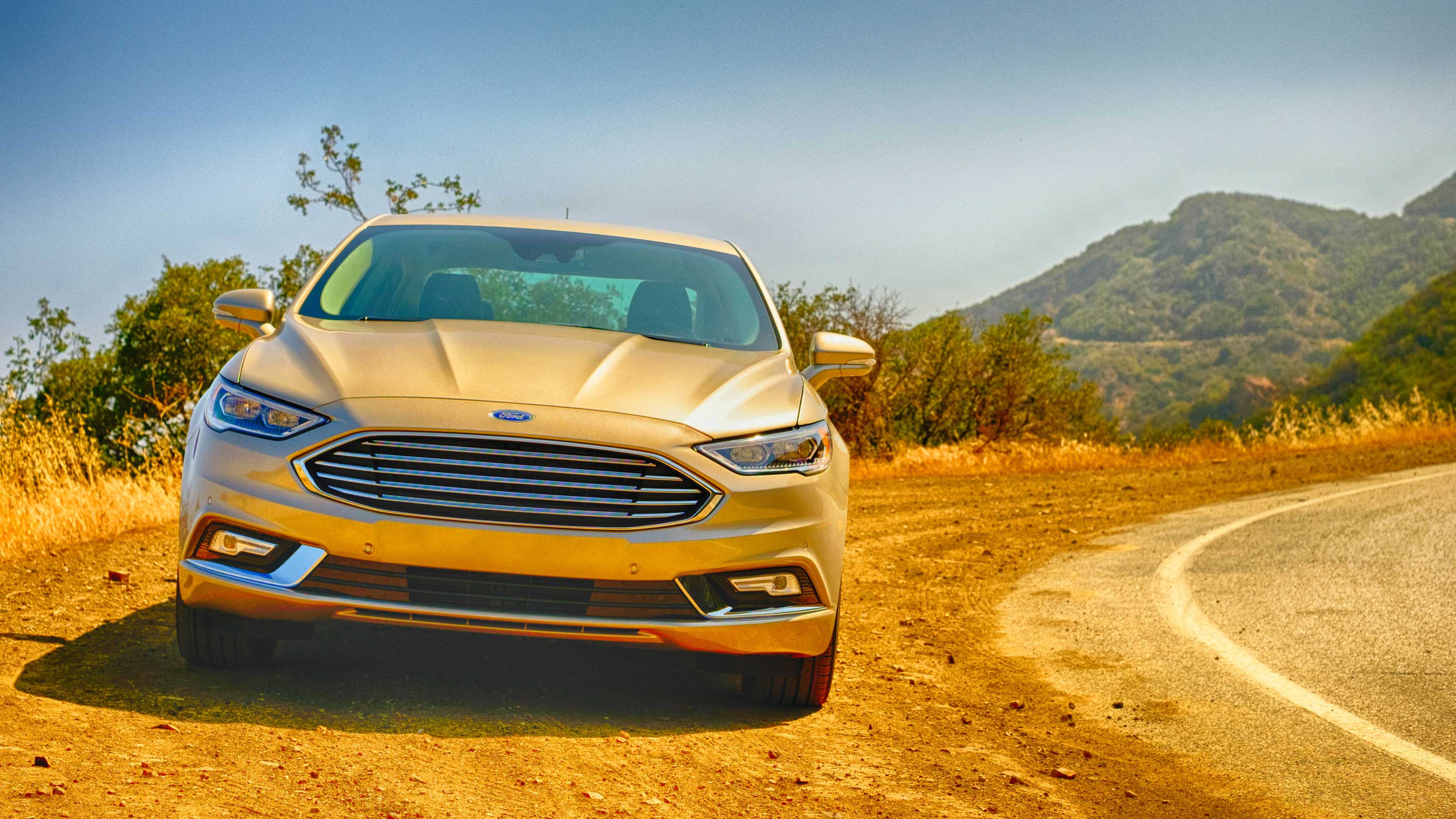
I remember when Ford unveiled the second-generation Fusion (or fourth-generation Mondeo for those across the Atlantic) for the 2013 model year – it was drop-dead gorgeous. The design borrowed sexy styling cues from Aston Martin, but packaged them into a practical mid-size sedan.
It was an athletic car that demanded to be pushed on windy roads, so much that I even received a speeding ticket in a Fusion Energi plug-in hybrid (not my highest point). The SYNC with MyFord Touch infotainment system was frustratingly slow, however.
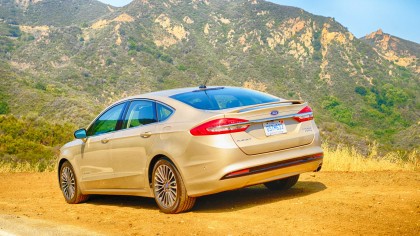
After four model years, Ford is giving the Fusion the technology upgrade it desperately needed along with some visual tweaks. The styling changes are minor, but swapping out SYNC with MyFord Touch for SYNC 3 solves my biggest annoyance with the outgoing Fusion.
To sample the freshened Fusion line-up, I packed my bags and returned to southern California – where Darren Murph drove the 2017 Ford Escape last month – to spend a day driving a trio of Fusion's through twisty roads that that would make a Toyota Camry cry.
SYNC 3 makes everything better
Ford installs SYNC 3 in the 2017 Fusion, which is my favorite infotainment system in a car. It's simple, responsive and has fluid transition animations. Apple CarPlay and Android Auto sweetens SYNC 3 even more.
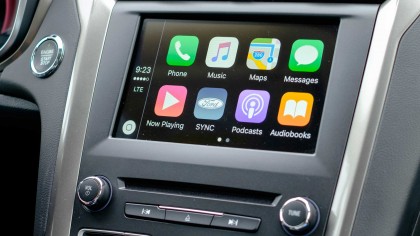
The Apple CarPlay and Android Auto support in SYNC 3 has one neat trick that no other car has: it completely takes over the infotainment system.
Most conveniently, when CarPlay or Android Auto is connected, your phone takes priority so a single press of the voice recognition button triggers Siri or Google Now.
Get daily insight, inspiration and deals in your inbox
Sign up for breaking news, reviews, opinion, top tech deals, and more.
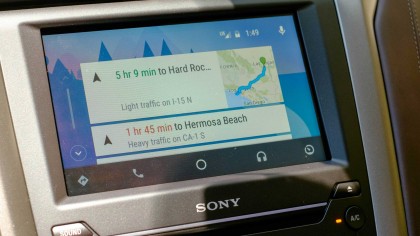
Other cars typically require holding down the voice command button for a couple seconds to activate Siri or Google Now, since the native infotainment software takes priority.
This little convenience leads me to believe Ford completely embraces the future of phone connectivity, instead of adding it as a feature because its competitors have it.
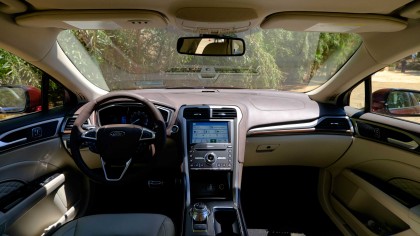
Ford ditched the traditional bulky automatic shifter in the 2017 Fusion for a more Jaguar-like rotary dial. The new dial frees up space so you can fit a 32-ounce Slurpee without interfering with the shifter.
Control it from a smartphone
The Fusion is the second car to get SYNC Connect technology, Ford's telematics service. SYNC Connect lets you control the Fusion from a smartphone app so you can remote start, lock, unlock and locate the car.
You can program the remote start on a schedule so the car is ready to go when you leave for work every day. Ford also teamed up with Amazon to bring Amazon Echo support to SYNC Connect.
An app for Amazon's Echo should arrive later this year and let you control Sync Connect features via Alexa commands.
While Ford is fashionably late with its telematics technology, you get five years of complimentary service via AT&T's LTE network instead of the typical short trial periods. There are no Wi-Fi hot spot capabilities, unfortunately.
Full-speed adaptive cruise control
Ford offered adaptive cruise control (ACC) on the Fusion since launch, but it required driver intervention if traffic slowed down to 20 mph or lower. Meanwhile, competitors like the Kia Optima, Subaru Legacy and Hyundai Sonata could completely stop the car.
ACC in the Fusion gets an upgrade to Ford's first full-speed system, so you can endure bumper-to-bumper traffic without touching the gas or brake. I briefly tested out the adaptive cruise control in traffic and found it fairly smooth.
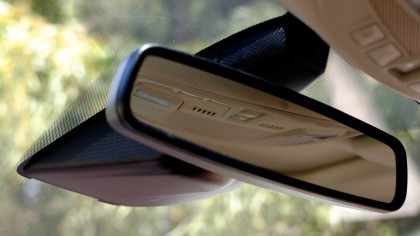
Lane keep assist (LKAS) is also available in the 2017 Fusion. Ford employs a basic system that nudges the car back into the lane if you approach or cross the lane marker – the sensitivity is adjustable in the vehicle settings.
It's not a steering assist system that actively steers the car with minimal effort, like in the Acura ILX. You can turn off LKAS if you wish, or have it serve as a warning system that alerts you through steering wheel vibrations.
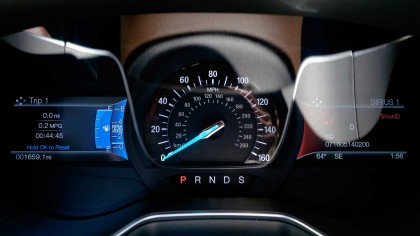
Rounding out the available driver assists is automatic emergency braking (AEB) detection and blind spot monitor. Ford calls it pre-collision assist with pedestrian detection, but its purpose is to automatically apply the brakes if it detects a potential collision and the driver hasn't intervened.
It does provide warning before applying the brakes, however. Ford integrates a head-up display of bright red lights to warn you, which is one of my favorite warning methods because it grabs your attention without taking your eyes off the road.
Driving it
Ford has five four-cylinder powertrain options available: a base 2.5-liter, a turbocharged EcoBoost 1.5-liter, turbocharged EcoBoost 2.0-liter, hybrid and plug-in hybrid. All but the base 2.5-liter powertrain were available to drive. There's a Fusion Sport model with a twin turbo EcoBoost 2.7-liter V6 engine arriving later this summer, but that wasn't available to drive, unfortunately.
Front-wheel drive (FWD) is standard, but all-wheel drive is available with the 2.0-liter.
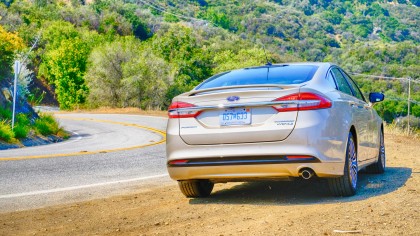
Starting with the Fusion Hybrid and Energi (plug-in hybrid), the powertrain receives enhancements that refine the transition between electric and gasoline motors. Overall, it's a smooth powertrain that should satisfy eco-friendly drivers.
I attempted to mash the gas pedal from a stop but found the throttle laggy. However, once the car was rolling, the athletic driving dynamics kicked in and it was enjoyable to drive – just don't expect surges of power.
The 1.5-liter, turbocharged mid-level motor was my favorite engine. Power is unchanged from the outgoing model but it gains automatic start/stop technology like the Escape.
I'm usually not a fan of start/stop technology, but the Fusion smoothly shuts off the engine and starts it back up again with minimal noise or vibration. It was seamless and not something I'd notice if I was driving along with the stereo cranked up.
It may seem like a small motor, but the little 1.5-liter packs a punch with its 181 horsepower (hp) and 185 pound-feet (lb.-ft.) of torque. The car zips around town without breaking a sweat. It's very eager on the highway too, which makes passing other cars a breeze.
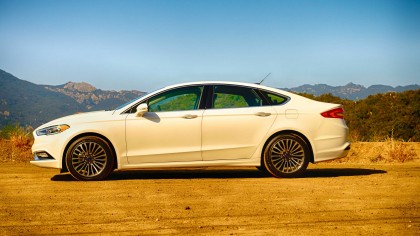
Stepping up to the 2.0-liter bumps power to 240 hp and 275 lb.-ft. of torque, but the car I drove had the optional AWD system, which adds more weight. There's no denying the 2.0-liter turbo motor provides extra grunt, but I don't think it's worth the extra cost and a 2 4 mpg (FWD and AWD) fuel economy penalty.
The little 1.5-liter motor strikes the right balance of low-end torque for zippy city driving and enough power to put a smile on my face. Don't get me wrong, the 2.0-liter was fun to drive, it just didn't provide a major leap to justify the cost, unless you want AWD, ACC or AEB.
Handling-wise, the Fusion is excellent. It doesn't dance as rhythmically as the lighter Mazda 6 on windy roads, but precise steering and road feel lets you gently feel the imperfections in the road while carving corners comfortably.
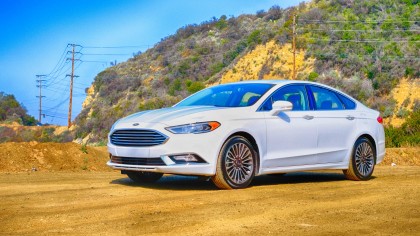
You do feel the weight, but there's minimal body roll and it's something I'm willing to overlook for the available powertrain, technology and amenities.
What we liked
When the Fusion first arrived for the 2013 model year, infotainment systems from all automakers, including Ford, were a mess. The long development cycles of cars couldn't keep up with the six-month smartphone cadences so in-car systems were a slow and unresponsive mess.
Ditching the Microsoft-based SYNC with MyFord Touch completely transformed the driver seat experience. The old system was slow, clunky and unresponsive while the QNX-based SYNC 3 is buttery smooth with slick transition effects.
Ford's pure gasoline powertrains are extremely refined, with a smooth-shifting six-speed automatic and one of the smoothest implementations of automatic start/stop technology I've driven.
What we didn't like
Now if you're like me and want something with more performance, there's always the upcoming Fusion Sport, which is a proper successor to the earlier Taurus SHO from the late 80s and early 90s.
I'm not too fond of the Fusion Hybrid or Energi. I find the throttle response very laggy, which is fine if you drive economically, but I do not. You also give up a significant chunk of trunk space to make room for the battery pack.
Also, I find it hard to recommend the EcoBoost 2.0-liter unless you need the added power, AWD, ACC or AEB. But, that's just because the EcoBoost 1.5-liter is perfect for everyday driving.
The competition
The competition is tough. The Toyota Camry and Honda Accord dominate sales in the segment, as the Hyundai Sonata and Kia Optima offer excellent features and amenities while the Mazda 6 has the best driving dynamics.
Luckily for Ford, the Camry is a snooze fest and Toyota's attempt at sporty is a different aesthetic with stiffer springs that do very little but to sacrifice ride comfort. Toyota's disdain for Android Auto and Apple CarPlay leaves it with an infotainment system that tries too hard to solve a problem that Apple and Google already have.
The Nissan Altima is just as much of a bore as the Toyota Camry, with an equally terrible infotainment system.
I don't have any technical qualms with the Honda Accord, since it's one of two mid-size sedans offered with a six-speed manual. However, I find the Accord seats painful for my 5-foot 7-inch and 195-pound frame.
Then there's the fraternal Korean twins, which I like and have recommended in the past. But, Hyundai and Kia played it safe by offering its 1.6-liter turbocharged motor and dual-clutch transmission only with a fairly stripped down Eco trim level instead of the full shebang, like Ford.
The lightweight Mazda 6 is a fantastic driving car, but it loses out in the technology department. Mazda's OpenCar-based infotainment system has good ergonomics with the control knob and touch screen interface, but the lack of Apple CarPlay and Android Auto makes it feel archaic, despite Mazda being a partner for both.
Lastly, there's the two other American mid-size sedans: the Chrysler 200 and Chevrolet Malibu. Chrysler is phasing out the 200 within the next five years, because it didn't stand out. I recently drove the Chevrolet Malibu and liked the MyLink infotainment system with Android Auto and Apple CarPlay support, but I felt it was more like a Camry with sharper styling and better technology than a thrilling drive.
Final verdict
The Ford Fusion has always been one of my favorite mid-size vehicles to drive and look at, but the addition of SYNC 3, Apple CarPlay, Android Auto and full-speed ACC turns it into the car you should buy. It's a mid-size sedan that can flex its athletic muscle on a weekend getaway, ease your commute with its full-speed ACC and play nice with your iPhone or Android smartphone.
Ultimately, if I was shopping for a mid-size sedan, the Fusion is the one I would grab. It's a perfect combination of thrilling driving dynamics, engine performance, technology and comfort packaged in a sexy mid-size sedan.